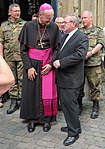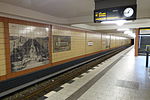Şehitlik Mosque
DITIB mosqueMosques in Berlin

The Şehitlik Mosque is a Sunni mosque in Neukölln, Berlin, Germany, operated by Ditib. Completed in 2005, the mosque building was designed in an Ottoman revival style by Hilmi Şenalp. The four storied building can house 1500 worshipers. The complex also includes a cultural center, and an information and meeting center. The mosque took its name from the Turkish cemetery, which was laid out as a diplomatic cemetery back in 1866. Among the graves of honor there are those for the Armenian genocide perpetrators Cemal Azmi and Bahattin Şakir, which was criticized by Kurdish-German politician Giyasettin Sayan in 2005.
Excerpt from the Wikipedia article Şehitlik Mosque (License: CC BY-SA 3.0, Authors, Images).Şehitlik Mosque
Columbiadamm, Berlin Neukölln
Geographical coordinates (GPS) Address External links Nearby Places Show on map
Geographical coordinates (GPS)
| Latitude | Longitude |
|---|---|
| N 52.481388888889 ° | E 13.409722222222 ° |
Address
Şehitlik-Moschee
Columbiadamm 128
10965 Berlin, Neukölln
Germany
Open on Google Maps









